- What are the barriers to the adoption of electric cars?
- Although the main financial and technological obstacles have been removed, its market share still needs to increase.
- In a recent study, a University of Geneva (UNIGE) team investigated the cognitive factors that still dissuade many people from switching to electric cars. They found that car owners systematically underestimate the capacity of electric driving ranges to meet their daily needs.
What are the barriers to the adoption of electric cars? Although the main financial and technological obstacles have been removed, their market share still needs to increase.
In a recent study, a team from the University of Geneva (UNIGE) investigated the cognitive factors that still dissuade many people from switching to electric cars. They found that car owners systematically underestimate the capacity of electric driving ranges to meet their daily needs. These results, published in Nature Energy, open up new avenues to speed up the electrification of mobility in addition to conventional policy approaches.
The increase of greenhouse gases (GHG) in the atmosphere is one of the main causes of global warming. Among the GHGs is carbon dioxide — the well-known CO2 — of which the transport sector is one of the main emitters. Fossil fuel vehicles alone account for nearly 18% of global CO2 emissions. The electrification of the vehicle fleet has therefore become one of the major challenges of the energy transition.
The number of electric vehicles is increasing in many countries. However, they are still far from having the market share that would allow a significant reduction in road traffic emissions. In 2020, they represented only 1% of the global vehicle fleet, including hybrid vehicles. To meet the 2030 climate targets, this proportion needs to reach at least 12%.
It’s (almost) all in the head
Now that the main financial and technological barriers have been removed (more affordable purchase prices, financial incentives, denser network of charging stations), what factors are still blocking widespread adoption of this mode of transportation? A large part of the answer lies in the cognitive biases and shortcuts of car drivers.
“Until now, initiatives related to the energy transition generally focused on the technological and financial barriers to their realization. Psychological factors have been given very little consideration. However, many studies show that individuals do not automatically adopt the behaviors most beneficial for themselves or society, often due to a lack of access to complete information,” explains Mario Herberz, first author of the study and researcher at the Consumer Decision and Sustainable Behavior Laboratory of the Department of Psychology at the Faculty of Psychology and Educational Sciences of the UNIGE.
The solution: tailored information
By interviewing more than 2,000 car drivers of different backgrounds and ages in Germany and the United States, the UNIGE scientists identified the source of the cognitive biases that were holding them back from adopting an electric vehicle. “We observed that the participants systematically underestimated the compatibility of electric battery capacities available on the current market with their real needs,” says Tobias Brosch, director of the Consumer Decision and Sustainable Behavior Laboratory and last author of the research.
In other words, consumers wrongly believe that the autonomy of current batteries is not sufficient to cover their daily journeys. This underestimation is substantial, the researchers estimating it at around 30%. “To reassure people, the solution is not only to densify the network of charging stations or to increase the size of batteries, which require scarcer resources such as lithium and cobalt. It is the provision of information adapted to the concrete needs of drivers that will reduce their concern and increase their willingness to adopt an electric vehicle,” explains Mario Herberz.
250 kilometers, the ideal range
The research team found that more than 90% of car trips could be completed with vehicles with a driving range of 200 kilometres, a modest range among the currently available batteries. “The trend is to increase performance, but we have observed that a greater range, beyond 300km, for example, does not increase the fit to daily needs. It would only have a minimal impact on the number of additional trips that can be completed with one electric charge. Therefore, increasing the size of the batteries is not a key element in the energy transition,” says Mario Herberz.
This research, partly financed by the Swiss Federal Office of Energy, demonstrates the importance of psychological factors and access to relevant information when implementing the energy transition. It opens up new avenues for promoting the electrification of mobility with scientifically informed interventions, as a complement to conventional policy approaches.
—
Publication Referenced in the Article:
Mario Herberz, Ulf J. J. Hahnel, Tobias Brosch. Counteracting electric vehicle range concern with a scalable behavioural intervention. Nature Energy, 2022; DOI: 10.1038/s41560-022-01028-3
—
This article was written by the Université de Genève.









Comments